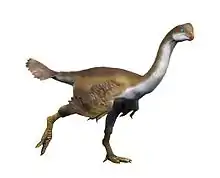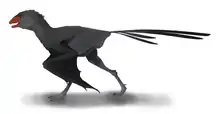Pyroraptor
Pyroraptor (meaning "fire thief") is a genus of dromaeosaurid dinosaur from the Late Cretaceous of what is now southern France and northern Spain, it lived during the late Campanian and early Maastrichtian stages, approximately 70.6 million years ago. It is known from a single partial specimen that was found in Provence in 1992. The animal was named Pyroraptor olympius by Allain and Taquet in 2000.
| Pyroraptor | |
|---|---|
 | |
| Skeletal diagram, described fossils shaded | |
| Scientific classification | |
| Kingdom: | Animalia |
| Phylum: | Chordata |
| Clade: | Dinosauria |
| Clade: | Saurischia |
| Clade: | Theropoda |
| Family: | †Dromaeosauridae |
| Genus: | †Pyroraptor Allain & Taquet, 2000 |
| Species: | †P. olympius |
| Binomial name | |
| †Pyroraptor olympius Allain & Taquet, 2000 | |
Discovery and naming

The first remains of Pyroraptor were discovered in southeastern France, at the La Boucharde locality of the Arc Basin in Provence. Finds of dromaeosaurid dinosaur remains are rare in Europe, and typically provide little taxonomic information. The first dromaeosaurid fossils found in France were those of Variraptor, although the bones were previously referred to a new Megalosaurus species.[1]
Pyroraptor was described by French paleontologists Ronan Allain and Philippe Taquet in 2000, the type species is Pyroraptor olympius. The genus name is Greek for "Fire thief", due to its remains being discovered after a forest fire occurred. The species name is derived from Mont Olympe, a mountain in Provence at the foot of which the animal's remains were unearthed.[1]
The holotype specimen, MNHN BO001, consists of the second toe claw of the left foot. The assigned paratypes include the equivalent claw of the right foot; the left second metatarsal; another, more complete second toe claw; a right ulna (long forearm bone); and two teeth. Additional material from the Vitória Formation and the Tremp Group, both in Spain, was referred to Pyroraptor, including five pedal digits, one manual digit, a piece of a metacarpal, a right radius, a dorsal vertebra, and a tail vertebra.[1]
Description

Pyroraptor was a dromaeosaurid, a small, bird-like predatory theropod that possessed enlarged curved claws on the second toe of each foot. In Pyroraptor, these claws were 6.5 centimeters (2.5 in) long. As in other dromaeosaurids, these claws might have been used as weapons[2] or as climbing aids.[3] Its two known teeth are flattened and curved backwards, with their rear margins having finer serrations than at the front.[1]
As a dromaeosaurid, Pyroraptor likely had well-developed forelimbs with curved claws, and probably balanced the body with a long, thin tail. Pyroraptor was also likely covered in feathers, as many of its relatives, like Microraptor and Sinornithosaurus, also had plumage.[4]
See also
References
- Allain, R., and Taquet, P. (2000). "A new genus of Dromaeosauridae (Dinosauria, Theropoda) from the Upper Cretaceous of France." Journal of Vertebrate Paleontology, 20: 404-407. [June 27, 2000]
- Carpenter, Kenneth (1998). "Evidence of predatory behavior by theropod dinosaurs" (PDF). Gaia. 15: 135–144.
- Manning, Phil L., Payne, David., Pennicott, John., Barrett, Paul M., Ennos, Roland A. (2005) "Dinosaur killer claws or climbing crampons?" Biology Letters (2006) 2; pg. 110-112 doi:10.1098/rsbl.2005.0395
- Scott Sampson in Discovery Channel's 2003 documentary series Dinosaur Planet, ep. 2: "Pod's Travels".
External links
- Pyroraptor official site, in French
- Pyroraptor computer animation, by Meteor Studios for Discovery Channel
- Pyroraptor computer animation stills by Meteor Studios for Discovery Channel






.png.webp)



.jpg.webp)





